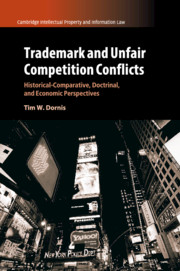Contents
2Common Law History—United States
3A Ragged Landscape of Theories
4Modern Soft Law—WIPO Recommendation, ALI Principles, and Others
5The American Scholarly Debate
ICommon Law Tradition and Transnational Market Protection
BThe Nintendo Transformation: From Act-of-State-Doctrine to Substantive Dichotomy
CThe Revival of Territoriality: A Quasi Continental Choice-of-Law Approach
DThe “Domestic Extraterritoriality” of Statutory Trademark Rights
ETea Rose/Rectanus “Transnationalized”: The Common Law Cross-Border Crusade
FThe Shift to Effects Testing: An Idea of Transnational Market Regulation
IIAnalysis: Common Law Tradition Meets Extraterritorial Market Regulation
4Substantive Policy—Convergent Foundations
1Foundations—The Market Mechanism
2Implementation—Substantive Law
IIIThe Intellectual Property Dichotomy: Innovation vs. Competition
IVTrademark and Unfair Competition Law: Framing the Information Infrastructure
3Application—Functional Structures in Trademark and Unfair Competition Doctrine
5International Comity—A Doctrine of Self-Restraint
1From Comitas Gentium to Transnational Law
IThe Status Quo: A Publicization of Private International Law
IIIn the Shadows: The Creeping Deformation of Comity
ATransnationalization: A Resurrection of the Ius Cosmopoliticum
BThe Historical Leitmotif: Convenience of International Transacting
CThe Modernity of Transnational Law: An Apotheosis of Substantive Uniformity
3The Shadowy Existence of Trademark and Unfair Competition Conflicts
6Reconceptualization, Reinterpretation, and Typology
2The Reinterpretation of Steele and Rome II

